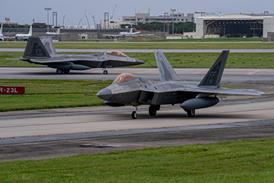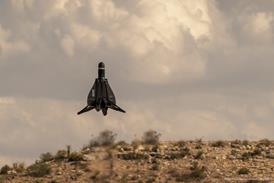Ramon Lopez/FORT WORTH
Boeing's Phantom Works is seeking the involvement of a US Government research organisation to build a large-scale flying model of the company's Advanced Theater Transport (ATT) concept aircraft. The company reckons the aircraft could be operational by 2013-5.
The Phantom Works already has research and development agreements with US Air Force researchers on ATT. But company representatives are talking with NASA and the Defense Advanced Research Projects Agency (DARPA) about advanced research contracts that could include fabrication and flight testing of a large manned or radio-controlled demonstrator. Boeing has already responded to a NASA advanced aircraft research request for proposals issued six months ago.
An adaptation of the 1960s tilt-wing concept, the No-Tail ATT super short take-off and landing (SSTOL) transport, also known as Super Frog, would be capable of lifting 30t loads into 229m (750ft)-long unprepared air strips.
The ATT uses counter-rotating port and starboard propellers and split flaps/ailerons for lateral control.
For SSTOL, the ATT's wing is tilted up to 42° to increase lift, using two jackscrew actuators housed within the wing/fuselage fairing. Low-speed lift is augmented by propeller flow over the wing. The 39m-span wing is swept to cover 80% of the compact 27.5m-long fuselage. The ATT would be powered by four 9,000kW (12,000shp)-class turboprops, cross-shafted for redundancy.
Fully loaded, the Super Frog is projected to have a range of 3,300km (1,785nm). It has a similar fuselage diameter to the Boeing C-17, but would carry around 40t into conventional airfields - half the larger aircraft's load, but up to four times the load of a Lockheed Martin C-130J.
Boeing has already completed windtunnel tests of a subscale aircraft model.
Last year it conducted tethered and untethered flights tests with a 7% (2.5m) scale model. Phantom Works plans to settle on the ATT's final configuration by the end of the year, says the company.
ATT would not satisfy Future Transport Rotorcraft vertical-lift requirements, but the USAF's Special Operations Command might replace its C-130s with a SSTOL transport and tanker variant. The US Army also has an unfunded requirement for an SSTOL aircraft.
The Defense Science Board sees a US military requirement for such an aircraft operating from sea bases.
It recommends that the USAF and DARPA begin concept definition of a new SSTOL intra-theater transport with initial fielding in 2015. It said the aircraft should be shipboard-capable with at least C-130J payloads.
Source: Flight International























